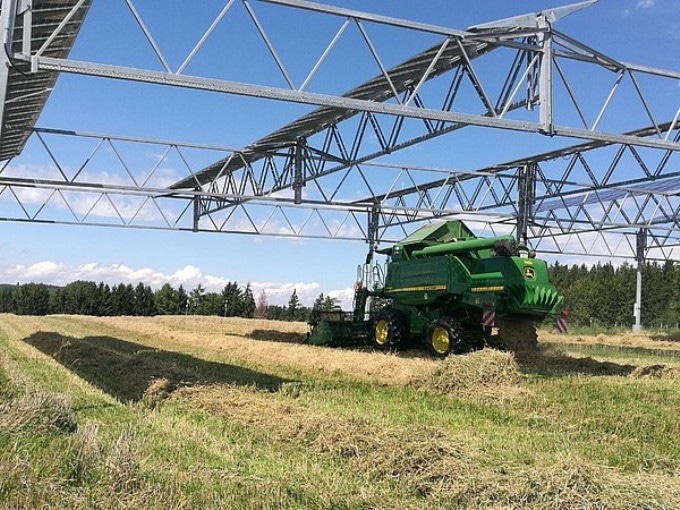Nov 28 2017
Until recently, acreage was chosen for either photosynthesis or photovoltaics, that is, to produce grow crops or electricity. An agrophotovoltaics (APV) pilot project near Lake Constance, however, has currently showed that both uses are compatible.
Twofold use of land is resource efficient, decreases competition for land and further opens up a new source of income for farmers. For one year, the largest APV system in Germany is being tried out on the Demeter farm cooperative Heggelbach. In the demonstration project “Agrophotovoltaic – Resource Efficient Land Use” (APV-Resola)” led by the Fraunhofer Institute for Solar Energy Systems ISE, solar modules for electricity manufacture are installed directly above crops spread across an area of one third hectare. Presently, the first solar harvest of produce and power has been gathered on both levels.
 The first grain harvest of the APV system is being gathered. | Image: Hofgemeinschaft Heggelbach / Olivia Schmid | more press photos in print quality
The first grain harvest of the APV system is being gathered. | Image: Hofgemeinschaft Heggelbach / Olivia Schmid | more press photos in print quality
The project results from the first year are a complete success: The agrophotovoltaic system proved suitable for the practice and costs as much as a small solar roof system. The crop production is sufficiently high and can be profitably sold on the market.
Stephan Schindele, Project Manager of Agrophotovoltaics, Fraunhofer ISE
“Agrophotovoltaics (APV) has the potential to open up new space that is urgently needed for the PV expansion in Germany. At the same time APV can mitigate the conflicting interests between agriculture and open space PV systems for viable land. Before market readiness, however, other sectors and differently sized systems still must be tested. Also, the technical integration must be further advanced, for example, the implementation of storage,” remarks Prof. Hans-Martin Henning, Institute Director of Fraunhofer ISE.
Winter wheat, celeriac, potatoes and clover grass were the first crops to be tested. The south-west orientation and the additional distance between the five meter high rows of bifacial glass-glass PV modules guaranteed that the crops were exposed to even solar radiation.
Solar module shading reduces crop yield – total balance positive
The results from the first harvest were quite promising.
The crop yield of clover grass under the PV array was only 5.3 percent less than the reference plot. The yield losses for potatoes, wheat and celeriac are between 18 to 19 percent and therefore somewhat higher.
Prof. Petera Högy, Agricultural Expert, The University of Hohenheim
“From the perspective of agricultural science, agrophotovoltaics is a promising solution for increasing both the land use efficiency and the share of renewable energy provided by the agricultural sector,” stresses Prof. Iris Lewandowski, Head of the Department of Bio-based Products and Energy Crops, University of Hohenheim. The experts agree that it is vital, however, to collect more experience over the following few years and test other crops prior to making final conclusions.
Solar Array Produces More Than Average
The 720 bifacial solar modules create solar electricity not only on the front side but also on the back of the photovoltaic modules with solar radiation redirected from the surroundings. Under positive ambient conditions, for example snow cover, 25% extra electricity yield can be accomplished. From an energy stand point, the dual use principle of agrophotovoltaics is a lot more efficient than exclusively planting energy crops, accounting, merely, for 18% of agricultural land use in Germany.
With an installed power of 194 kW, the photovoltaic array can provide 62 four-person households with electricity. In the initial 12 months, the array generated 1266 kWh electricity per installed kilowatt, one third more than the average value of 950 kWh/kW in Germany.
The power production from the experimental field coordinated well with the daily farm load. Around 40% of the electricity generated on the farm was used straightaway to process the harvested crops and charge the electric vehicles. In summer, the load demand could be nearly fully met by the photovoltaic system. Thomas Schmid and the other Demeter farmers aim to boost their self-consumption up to 70% by enhancing their consumption behavior and setting up an electricity storage system. The excess PV electricity is fed into the Elektrizitätswerke Schönau, an electric utility company based on 100% renewable energy and a collaborator in the project.
Agrophotovoltaic – Resource Efficient Land Use (APV Resola) Project
Since the idea of agrophotovoltaics was first started by Prof. Adolf Goetzberger, who founded Fraunhofer ISE in 1981, a number of large APV plants have been set up globally. On the other hand, only a few of these APV plants are chosen as research sites. In the “APV Resola” project, researchers are for the first time examining the economic, societal, technical and ecological aspects of the technology in a pilot plant under real conditions.
The research project is supported by funds from the German Federal Ministry of Education and Research (BMBF) and the Research for Sustainable Development (FONA).
The project’s goal is to make the APV system technology into a market-ready product.
In order to provide the necessary proof-of-concept before market entry, we need to compare further techno-economical applications of APV, demonstrate the transferability to other regional areas and also realize larger systems.
Stephan Schindele
For instance, different potential applications will be explored along with fruit, hops, berries and wine crops and with the several technologies such as special films with organic solar cells, energy storage, and solar PV water treatment systems.
“Besides investment from industry and research policy, appropriate political measures supporting the technology are of vital importance for a successful market entry,” adds Stephan Schindele.
Already in 2014, Fraunhofer ISE and the Wuppertal Institute, supported together by the University of Hohenheim, made a joint statement suggesting that agrophotovoltaics be considered independently in invitations for tender while in the test phase.